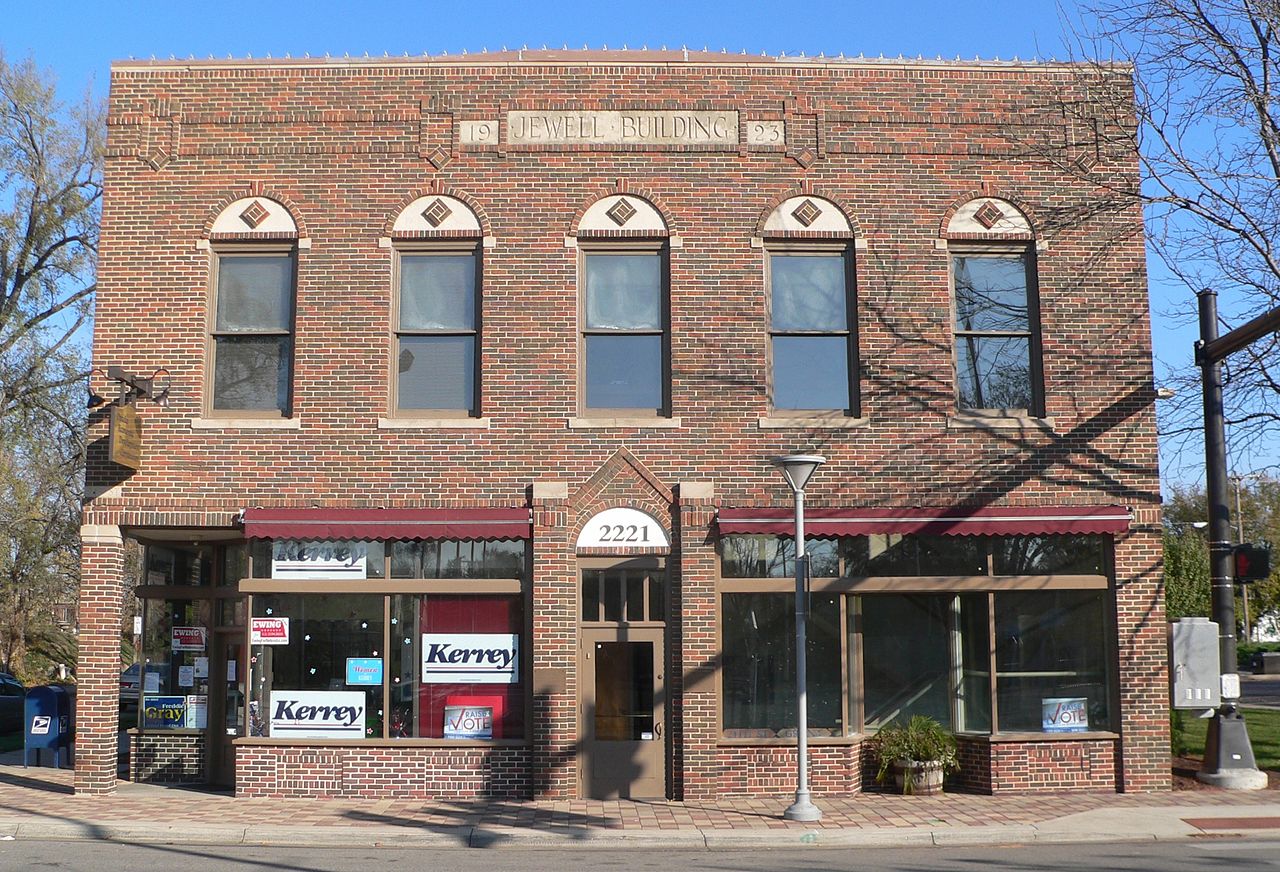50 STATES OF FOLK: A Jazz Incubator in Nebraska’s North Omaha

The Jewell Building in North Omaha, Nebraska. (Photo via Ammodram / Wikimedia Commons / Public Domain)
When most people think of big-band jazz, they’re probably thinking of glittery urban scenes in the Roaring ’20s. They’re thinking art deco dancehalls and Prohibition-era speakeasies. There’s something about the idea of a brassy jazz band that evokes imagery of New Orleans, Chicago, and New York City.
But there’s so much more to the story. One of the most vibrant and industrious jazz scenes in America built itself from the ground up right in the heart of the country in Omaha, Nebraska.
Cattle, Race, and the Union Pacific Railway
Before the historic district around North 24th and Lake streets became the epicenter of Black culture in Omaha in the 1900s, it was first a landing ground for settlers in the Nebraska Territory in the mid-1800s. Originally no more than a general store, a grocery store, and a stable, the crossroads soon blossomed into a thriving community.
By the 1870s, Omaha had a booming cattle industry powering its economy. Western Nebraska is a good place to raise cattle — it’s surrounded by abundant flat, grassy plains, so there’s plenty of space for the cows to move around and lots of grass for them to eat. But there was one major problem that Omaha farmers were facing: The nearest stockyard was in Chicago. In the 500-mile-plus journey, their cattle would lose weight, which meant that the Omaha farmers were losing money.
So in the late 19th century investors looked around and realized they had everything they needed to set up a stockyard of their own. They had space, they had a fast-moving river to carry waste runoff away (unlike Chicago’s river, which often became backed up with putrid meatpacking waste), and they had one of the largest railroad companies in the United States headquartered in their city. So they got started, and in 1883, the Union Stockyards of Omaha was founded in South Omaha.
Because of the power and influence of the new stockyard, Omaha was serviced by every major railway company by the late 1880s. The city became an attractive target for Black Americans moving north in search of a better life and opportunities in the Great Migration. By the 1910s, North Omaha had transformed from a sleepy suburb of Omaha into a bustling Black district, filled with Black-owned businesses like blacksmiths, grocers, and clubs, and at its heart was the intersection of North 24th and Lake streets.
However, with Black economy power and community growth came racist backlash. As racialized tension violence swept through the Midwest in the late 1910s and early 1920s (most famously resulting in the Tulsa race riots in Oklahoma), Omaha saw white residents lynching and attacking Black residents. With the Will Brown riots in 1919, North Omaha had its first wave of white flight, solidifying the area as a Black neighborhood (eventually resulting in redlining of the neighborhood in the 1920s).
As a result, the Black community of North Omaha was tightly knit. After the Will Brown lynching and the redlining of the district, segregation was strictly enforced in Omaha, via both institutional and informal means (some of which have lasting impacts to this day). So the only places that Black residents had to go for all their needs were the Black businesses of North Omaha.
It was under these conditions that jazz established itself as the dominant cultural force of the district.
Jazz and The Jewell Building
Jazz thrived in Omaha due to one historical coincidence: Thomas C. Durant — first head of Union Pacific Rail — and his arbitrary decision to start the transcontinental railroad in Omaha. Because of Omaha’s location as the central hub of all rail travel in the US, it was a convenient stop for touring bands playing shows across the United States. So when Black jazz and big-band acts were traveling between major musical hubs like Chicago, New Orleans, and Kansas City, they would always stop in Omaha for a night along the way. And due to segregation and racism in the white parts of town, the bands tended to end up on the north side.
At least, that’s how Dan Desdunes came into it. Originally trained as a classical musician, Desdunes picked up playing in minstrel shows as a way to make more money than he could as a music teacher and local dance orchestra leader. While on the road with a traveling show company, he came to Omaha and fell in love. It wouldn’t be long before Omaha fell in love with him, too.
Within four years, Desdunes was appointed the director of the Omaha Military Band (soon renamed the Dan Desdunes Band), which he then used as a tool to recruit musicians from New Orleans to relocate to Omaha. The Dan Desdunes Band itself didn’t play much jazz, as the money came from playing what white audiences wanted to hear (think marches, polkas, waltzes, and schottisches). However, it was a gig that paid, making it a vehicle to get talented early jazz musicians into town and collaborating with each other. When these musicians went back to their new homes in North Omaha and played the Black clubs at night, they were playing jazz. Through this work, Desdunes would train a generation of Omaha’s bandleaders, establishing music as a powerful driver of the culture of North Omaha.
That’s how places like the Jewell Building and its second-story Dreamland Ballroom came to be. After the Easter Sunday tornado of 1913 ripped up big portions of North Omaha, businessman Jimmy Grant Jewell looked at the ruins and saw an opportunity. As the city rebuilt and repaired, Jewell took the chance to provide something that he knew North Omaha needed: a high-class Black entertainment venue to host all the musical acts that came through town. And thus, the Jewell Building was born.
The Dreamland Ballroom would host some of the most famous, most influential, and most storied jazz musicians of the 20th century. Everyone from Fats Domino to Duke Ellington to Count Basie to Ray Charles played that room, which remained active and operational from 1923 to its last performance in 1965. It was places like the Dreamland that led Omaha native and jazz saxophonist Preston Love to once remark, “If New York, Chicago, and Kansas City were the major leagues of jazz, Omaha was the Triple-A.”
Impacts Today
Even though the art deco landmarks of Omaha’s jazz scene would eventually die out (only to be resurrected decades later by city historical commissions), the legacy would live on. Musicians who grew up and were nurtured by Omaha’s opportunities went on to have influential careers outside of Nebraska.
There is no better example of Omaha’s jazz greatness than saxophonist Preston Love. As a young man, Love often played as a sideman for nationally touring acts that came through town. But he wouldn’t get his big break until 1942, when he was offered a permanent role in Count Basie’s band after filling in for just one performance at an overnight stop in Omaha. He went on to tour with him for six years before returning to Omaha to lead his own orchestra, an experience he took with him when he later became the bandleader for Motown Records. Love’s impact and legacy was honored posthumously with the creation of Love’s Jazz and Art Center, located at the intersection of 24th and Lake streets, the ever-beating heart of jazz and culture of North Omaha and its thriving, resilient Black community.
NOTE: The author of this piece benefited tremendously from the immense archival efforts of North Omaha locals, particularly the work of Adam Fletcher Sasse and his North Omaha History website (featuring hundreds of articles offering deep dives into every aspect of the local history of North Omaha), and by the work of student historians and documentarians as part of the Omaha Public Schools’ “Making Invisible Histories Visible” project.
Enjoy this playlist of songs with connections to North Omaha:




